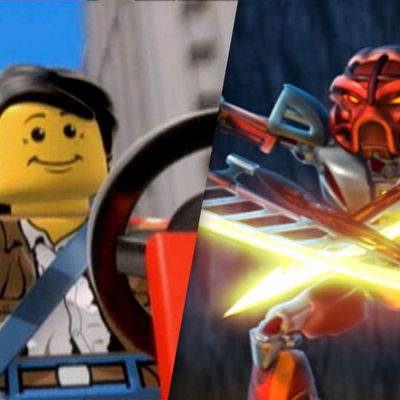
The theme song of The LEGO Movie is called “Everything Is Awesome,” which is both a joke and promise. Joke: Stifling corporate mediocrity rules every brick of the landscape overseen by pseudo-benevolent Lord Business, just like the real world. Promise: Unlike Lego’s previous ventures into movies, this time, it’s not just limited to kids — the irony of the song flying far over their heads. The LEGO Movie isn’t the company’s first feature — they’ve experimented with direct-to-video in-house originals and put Batman and the full Justice League through their paces — but it’s the first big one, the first one that adults might find themselves enjoying, and definitely the first one in which the story actually feels Lego-related.
Since its founding in 1932, the Lego name has earned the kind of more-than-a-brand sentimental childhood attachment arguably only achieved on a corporate scale by Disney. Inevitably, the company moved on from simple-colored blocks that could be built, dismantled, and reconstructed — their initial and simple product — to the 1978 introduction of mini figures to populate those worlds, and then to branded tie-ins; it was probably only a matter of time before Lego ventured into film. In a 1997 mission statement, the company declared its ambition to “be the most powerful brand in the world among families with children” by no later than 2005. 1999 brought the LEGO Star Wars set, followed the next year by the company’s first in-house fantasy story line Bionicle, which quickly leapt from the Internet to Lego kits and books. The immediate effect was strong and noticeable: By July of 2003, 40 million people worldwide had bought some kind of Bionicle product, which accounted for about a quarter of the company’s sales that year.
Lego’s first attempt at feature-length filmmaking, 2003’s Bionicle: Mask of Light was aimed at young consumers, with a standard-issue plot about a kid who moves up from mere hero’s helper to rescuer of the title mask via a series of generic fantasy incidents larded with an indecipherable internal lexicon. (No-explanation dialogue, like “Kohlii-head! You could’ve been Makuta bones!” probably doesn’t make any sense to you — Kohlii is the franchise’s Quidditch, Makuta one of its species of villains.) The Bionicle franchise’s relationship to Lego only had to do with its origin as a means to sell toy kits: In computer-animated form, neither the robot-looking protagonists nor their environment appear to be built from bricks. Their only visual kinship with actual Legos is the cost-saving fact that their mouths and eyes move but not their block-faced expressions as a whole. Two prequels and a sequel later, Lego stopped manufacturing Bionicle sets and an official storyline in 2010, while the line’s creative head Greg Farshtey finally gave up on any story updates last year.
In 2010, Lego also introduced their in-house Indiana Jones with a second stab at feature filmmaking. The Adventures of Clutch Powers makes its primary reference point clear early when Powers — a master builder capable of visualizing and assembling any kind of escape vehicle from loose bricks — whines, “Rock monsters? Why does it have to be rock monsters?” The lesson, as usual, for many children’s movies, is the importance of teamwork, repeatedly emphasized and alternated with minor lessons on other age-appropriate topics like the importance of buckling one’s seat belt.
It’s a harmless enough debut, with a minimum of internal mythology and unsurprising fantasy supporting figures (a prince who has to be restored to his rightful place, a bridge-guarding troll). Unlike the Bionicle gang, Clutch Powers and his heroic team occupy something like a recognizable Lego world, especially a castle with thin walls and drop-down drawbridge and a city whose orderly streets and grid layout sport a familiar tidiness. Still, despite Chance’s name and occasional building heroics, the environment of this feature doesn’t look that Lego-y otherwise.
Lego’s only other stand-alone feature-length endeavor to date was last year’s clumsily named Lego Batman: The Movie – DC Super Heroes Unite. Batman’s the star and Robin his too-often-dismissed sidekick, an obvious identification point for children tired of being told they’re not big or skilled enough to perform certain tasks. Superman has a supporting role as Batman’s least favorite sunny superhero and the Justice League show up for climactic cameos, but it’s basically the Dark Knight’s show. This movie’s visual relationship to Lego is even more tenuous, limited to square heads, stiffly grooved hair, and an unexpectedly funny gag where Batman and Superman disguise themselves by swapping connecting torsos and legs. This Batman is a little more kid-friendly than the recent Christian Bale model: sometimes comically grouchy and given to too much grousing (Robin actually chides him for rudeness at one point), but fundamentally still a masterfully intimidating superhero. Inhumanly rectangular torsos and all, it’s pretty familiar fare: The Joker cackles, Gotham City trembles, Bruce Wayne swoops in and saves the day.
The LEGO Movie directs attention to the company’s output as a whole, mix-and-matching new mini figures with already established tie-in additions: Shaquille O’Neal, Batman, whoever’s still licensed and available. As an exercise of showcasing all of the company’s current wares, it’s a way smarter strategic investment than focusing on a single story line whose appeal to kids will inevitably die out. If it’s a hit, it’s just the start: Look for the company to continue with plans to come full circle to its Bionicle days by bringing its nearly-as-complicated Ninjago TV series to the big screen. More fantasy, this time with jokes: The new movie confirms that Legos as inherently funny are the default new normal.




